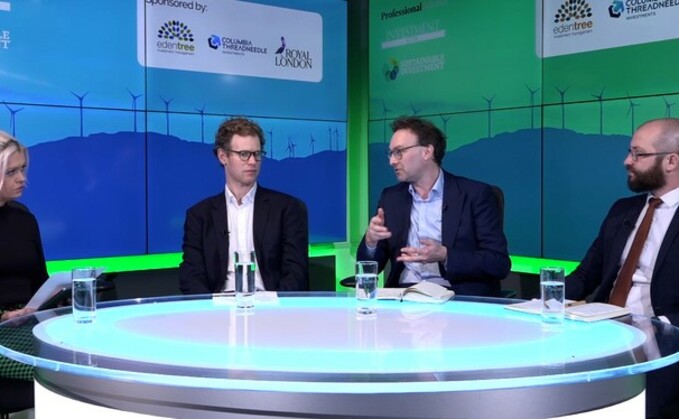Our sister title Sustainable Investment hosted a roundtable with the Sustainable Investment Alliance to discuss the outlook for different asset classes against the background of higher inflation and increasing regulatory scrutiny.
Sustainable Investment's editor Beth Brearley was joined by George Crowdy, Manager of the RLAM Global Sustainable Equity fund, Ben Kelly, Senior Thematic Analyst at CTI and Tommy Kristoffersen, Manager of the EdenTree Green Infrastructure fund.
We have seen a return to bonds recently due to higher inflation and rising yields. What is the outlook for the bond market?
Ben Kelly: We are going through a period where central banks are considering the next steps in terms of whether the inflationary data is meaningful enough for more rate hikes; I think it probably is. But where you get to ultimately is probably not too far from the levels we are at now. Year-to-date, we have seen huge inflows into investment grade credit, well over £5bn into the asset class, and that has been matched on the supply side as well. In terms of issuers coming to the market with new bonds, it has been the biggest year of issuance in the history of the issuance of new bonds in this market.
We have seen a huge influx of issuers wanting to put green bonds, social bonds and sustainability bonds in the market over the last four or five years. Last year was the anomaly because we didn't see a doubling of growth, but so far this year we are at over £200bn across green, social and sustainability bonds, and that's about an 80% increase on where we were this time last year. There seems to be no stoppage in terms of appetite from the issuers' side. From an investment side, clients are still interested in this asset class.
Until last year investors were using real assets as a bond proxy but that is starting to change. Where does that leave alternative investments such as green infrastructure?
Tommy Kristoffersen: That was the case at the end of 2022 with the response to low bond yields and people hunting for yield. But that represented an underestimation of what the infrastructure asset class is about and how it comes into its own in a portfolio context once you realise it is a genuine third asset class.
That changed and we were keenly aware of that because we launched the EdenTree Green Infrastructure fund on 28 September - the day gilt yields spiked to 4.5% and infrastructure at the time was yielding about 5%. People looked at that spread and questioned if they were willing to be paid a 50-basis-point spread to take on that extra risk.
What people didn't understand at that point was infrastructure assets tend to be strongly inflation linked in their cash flows. When people were looking at that 10-year gilt they weren't taking that inflation linkage into account.
Really you should be comparing a portfolio of solar farms - with three-year asset lives and inflation-linked cash flows - with a combination of a gilt and a 30-year inflation-linked gilt. Then even with the peak in yields you would see the 30-year linker paying about 2% and the spread for infrastructure is 100 to 200 basis points.
What is the outlook for green infrastructure?
Tommy Kristoffersen: The main thing is the long-term trend underpinning it. The drive towards net zero and energy security is not going away. The existing climate pledges require about $10trn over the next couple of decades, so that is a wall of capital coming into the sector.
What opportunities are there for equity investors currently?
George Crowdy: When we think about themes, we think five-to-10 years plus. Themes such as digitalisation, decarbonisation and innovation within the healthcare sectors. Many of those may have accelerated as a result of the higher inflationary environment we are in today. If you are the chief executive of a company in an inflationary environment, you will be squeezing your asset base to be more efficient.
In the near term the move to onshoring and bringing manufacturing back domestically is a powerful theme to be invested in, particularly in the United States.
Where do you stand on the divestment versus engagement debate?
George Crowdy: As a sustainable investor we set the bar pretty high for where we are going to invest in the first place. A company has to stack up in terms of what their products and services do and how they are contributing to a cleaner, healthier, safer, more inclusive society. Then we look for ESG leadership when it comes to a company managing its operations. There is no such thing as a perfect company; every company has room to improve in some way and we look to drive that through engagement. It is rare for us to divest from a company for sustainable reasons.
To watch the roundtable in full visit Sustainable-Investment.com








